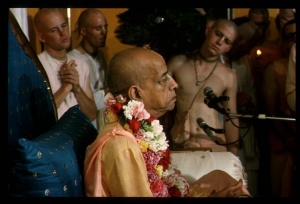CC Adi 7.22: Difference between revisions
m (1 revision(s)) |
No edit summary |
||
| Line 1: | Line 1: | ||
{{ | [[Category:Sri Caitanya-caritamrta - Adi-lila Chapter 07|C022]] | ||
<div style="float:left">'''[[Sri Caitanya-caritamrta|Śrī Caitanya-caritāmṛta]] - [[CC Adi|Ādi-līlā]] - [[CC Adi 7|Chapter 7: Lord Caitanya in Five Features]]'''</div> | |||
<div style="float:right">[[File:Go-previous.png|link=CC Adi 7.20-21|Ādi-līlā 7.20-21]] '''[[CC Adi 7.20-21|Ādi-līlā 7.20-21]] - [[CC Adi 7.23|Ādi-līlā 7.23]]''' [[File:Go-next.png|link=CC Adi 7.23|Ādi-līlā 7.23]]</div> | |||
{{CompareVersions|CC|Adi 7.22|CC 1975|CC 1996}} | |||
{{RandomImage}} | |||
==== TEXT 22 ==== | ==== TEXT 22 ==== | ||
<div | <div class="verse"> | ||
punaḥ punaḥ piyāiyā haya mahāmatta | :punaḥ punaḥ piyāiyā haya mahāmatta | ||
nāce, kānde, hāse, gāya, yaiche mada-matta | :nāce, kānde, hāse, gāya, yaiche mada-matta | ||
</div> | </div> | ||
| Line 12: | Line 16: | ||
==== SYNONYMS ==== | ==== SYNONYMS ==== | ||
<div | <div class="synonyms"> | ||
punaḥ | ''punaḥ punaḥ''—again and again; ''piyāiyā''—causing to drink; ''haya''—becomes; ''mahā-matta''—highly ecstatic; ''nāce''—dances; ''kānde''—cries; ''hāse''—laughs; ''gāya''—chants; ''yaiche''—as if; ''mada-matta''—one is drunk. | ||
</div> | </div> | ||
| Line 19: | Line 23: | ||
==== TRANSLATION ==== | ==== TRANSLATION ==== | ||
<div | <div class="translation"> | ||
Śrī Pañca-tattva themselves danced again and again and thus made it easier to drink nectarean love of Godhead. They danced, cried, laughed and chanted like madmen, and in this way they distributed love of Godhead. | Śrī Pañca-tattva themselves danced again and again and thus made it easier to drink nectarean love of Godhead. They danced, cried, laughed and chanted like madmen, and in this way they distributed love of Godhead. | ||
</div> | </div> | ||
| Line 26: | Line 30: | ||
==== PURPORT ==== | ==== PURPORT ==== | ||
<div | <div class="purport"> | ||
People generally cannot understand the actual meaning of chanting and dancing. Describing the Gosvāmīs, Śrī Śrīnivāsa Ācārya stated, kṛṣṇotkīrtana-gāna-nartana-parau: not only did Lord Caitanya Mahāprabhu and His associates demonstrate this chanting and dancing, but the six Gosvāmīs also followed in the next generation. The present Kṛṣṇa consciousness movement follows the same principle, and therefore simply by chanting and dancing we have received good responses all over the world. It is to be understood, however, that this chanting and dancing do not belong to this material world. They are actually transcendental activities, for the more one engages in chanting and dancing, the more he can taste the nectar of transcendental love of Godhead. | People generally cannot understand the actual meaning of chanting and dancing. Describing the Gosvāmīs, Śrī Śrīnivāsa Ācārya stated, ''kṛṣṇotkīrtana-gāna-nartana-parau'': not only did Lord Caitanya Mahāprabhu and His associates demonstrate this chanting and dancing, but the six Gosvāmīs also followed in the next generation. The present Kṛṣṇa consciousness movement follows the same principle, and therefore simply by chanting and dancing we have received good responses all over the world. It is to be understood, however, that this chanting and dancing do not belong to this material world. They are actually transcendental activities, for the more one engages in chanting and dancing, the more he can taste the nectar of transcendental love of Godhead. | ||
</div> | </div> | ||
__NOTOC__ | |||
<div style="float:right; clear:both;">[[File:Go-previous.png|link=CC Adi 7.20-21|Ādi-līlā 7.20-21]] '''[[CC Adi 7.20-21|Ādi-līlā 7.20-21]] - [[CC Adi 7.23|Ādi-līlā 7.23]]''' [[File:Go-next.png|link=CC Adi 7.23|Ādi-līlā 7.23]]</div> | |||
__NOTOC__ | |||
__NOEDITSECTION__ | |||
Revision as of 08:14, 6 July 2021

A.C. Bhaktivedanta Swami Prabhupada
TEXT 22
- punaḥ punaḥ piyāiyā haya mahāmatta
- nāce, kānde, hāse, gāya, yaiche mada-matta
SYNONYMS
punaḥ punaḥ—again and again; piyāiyā—causing to drink; haya—becomes; mahā-matta—highly ecstatic; nāce—dances; kānde—cries; hāse—laughs; gāya—chants; yaiche—as if; mada-matta—one is drunk.
TRANSLATION
Śrī Pañca-tattva themselves danced again and again and thus made it easier to drink nectarean love of Godhead. They danced, cried, laughed and chanted like madmen, and in this way they distributed love of Godhead.
PURPORT
People generally cannot understand the actual meaning of chanting and dancing. Describing the Gosvāmīs, Śrī Śrīnivāsa Ācārya stated, kṛṣṇotkīrtana-gāna-nartana-parau: not only did Lord Caitanya Mahāprabhu and His associates demonstrate this chanting and dancing, but the six Gosvāmīs also followed in the next generation. The present Kṛṣṇa consciousness movement follows the same principle, and therefore simply by chanting and dancing we have received good responses all over the world. It is to be understood, however, that this chanting and dancing do not belong to this material world. They are actually transcendental activities, for the more one engages in chanting and dancing, the more he can taste the nectar of transcendental love of Godhead.